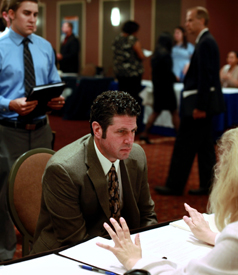The economic slump continues in the United States, as does the debate over where all the jobs have gone, and when — or if — they might return.
Mike Konczal, a fellow at the Roosevelt Institute, recently posted an excellent piece on his blog in which he examined why unemployment remains so high. He points out: “There are two theories at work. The first is a story of aggregate demand. The second theory is one of a mismatch in skills.”
What he doesn’t say explicitly — although it’s clearly implied — is that these two theories have very different policy implications. If the issue is aggregate demand (which is the total amount of goods and services that will be purchased in a given time frame) we should be doing everything we can to raise demand, including embarking on fiscal expansion and unconventional monetary policy. If it’s a mismatch in skills in the labor market, we should do nothing, because any effort to create jobs leaves part of the work of depressions undone. In this case, an economic slump actually serves a useful purpose, by ushering in economic change — which would mean that stimulating the economy, even through monetary policy, would be a mistake. So how do we decide which theory applies?
The answer is to look at the evidence — specifically, to ask whether what we see bears the signature of one story or the other. The aggregate demand story suggests that we should see depressed employment in all industries as workers of every skill type face a poor job market. The mismatch story says that we should see surpluses of labor in some places and shortages in others.
And Mr. Konczal shows that the data overwhelmingly fits the demand story, not the mismatch story. Every major industry in the United States has seen a rise in involuntary part-time work; so has every key occupation. There is no hint that labor in any sector is in short supply.
Click here to get Truthout stories like this one sent straight to your inbox, 365 days a year.
Let’s look at another piece of evidence — something I have touched on in recent columns. A September survey from the National Federation of Independent Business shows that smaller companies are much more concerned about weak sales than taxes or regulation, and concerns about the quality of available labor have plunged.
This strongly suggests that the labor market is weak in all sectors, and businesses are having no trouble finding the workers they need. But once they find those workers, given weak demand, the businesses just don’t know what to do with them.
———————————————
Backstory: The Roots of Joblessness
The National Bureau of Economic Research issued a welcome report on Sept. 20: the recession that began in December 2007 in the United States ended in June 2009.
This does not mean that economic indicators have quickly bounced back to pre-2007 levels. While the United States’s gross domestic product has grown since June 2009, the unemployment rate has remained high, and it now stands at about 9.6 percent. Economists are attempting to determine whether or not the underlying cause of the unemployment is structural in nature — affecting some parts of the economy but not others — or if it is cyclical.
The question is not merely academic, since a structural shift in the economy would mean that some jobs will never return. In this case, the composition of the entire workforce would have to change in order for the United States to remain economically vibrant and competitive.
While some economists have warned that the United States is undergoing a structural shift, skeptics point out that job losses have been spread across all sectors and regions, with all types of workers facing layoffs, no matter their age, occupation or level of education. Jobs have not returned due to the recovery’s feebleness, they say, rather than to any permanent change in the job market.
Still, there are no simple solutions. The economy would need to grow at an annual rate of 2.5 percent just to keep unemployment at its current high level, according to economists. Unfortunately, in the second quarter of this year, the annualized rate of growth was only 1.6 percent, with a similar rate projected for the third.
Truthout has licensed this content. It may not be reproduced by any other source and is not covered by our Creative Commons license.
Paul Krugman joined The New York Times in 1999 as a columnist on the Op-Ed page and continues as a professor of economics and international affairs at Princeton University. He was awarded the Nobel in economic science in 2008.
Mr Krugman is the author or editor of 20 books and more than 200 papers in professional journals and edited volumes, including “The Return of Depression Economics” (2008) and “The Conscience of a Liberal” (2007).
Copyright 2010 The New York Times Company.
Matching Opportunity Extended: Please support Truthout today!
Our end-of-year fundraiser is over, but our donation matching opportunity has been extended! Today, all donations to Truthout will be matched dollar for dollar. Your one-time gift today will be matched immediately. As well, your monthly donation will be matched for the whole first year, doubling your impact.
This matching gift comes at a critical time. Trump has made it no secret that he is planning a demolition-style attack on both specific communities and democracy as a whole, beginning on his first day in office.
Help us prepare for Trump’s Day One, and have your donation matched today!
